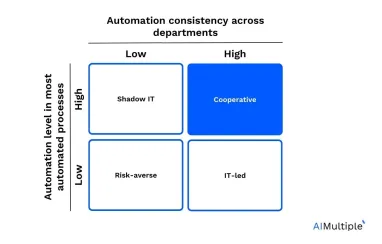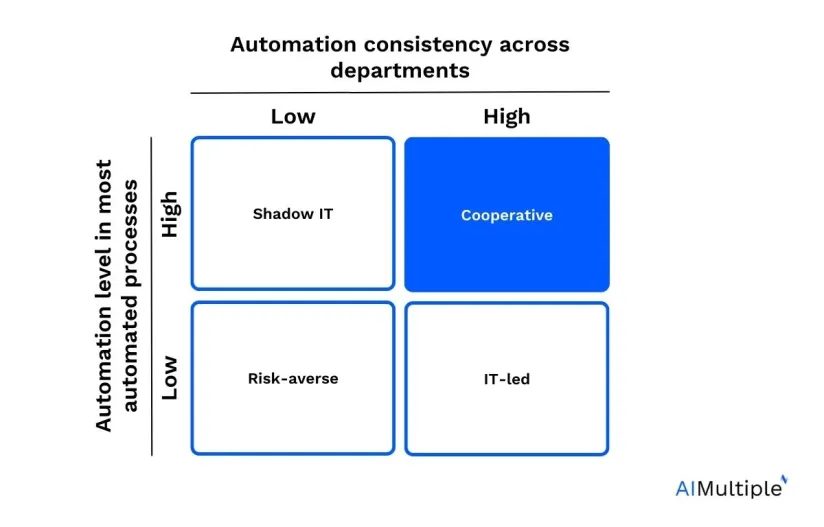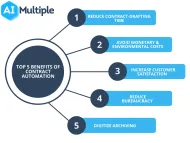Enterprise Automation with GenAI: 4 Principles & Best Practices


Automation is imperative and businesses are investing billions into it. However, results are mixed; app sprawl has led businesses to use hundreds of applications with limited utilization. Many firms are stuck in local optima without a consistently high level of automation across the enterprise.
Business and technology executives’ efforts to improve this situation are slowed down by bottlenecks in IT, organizational inertia and complex compliance criteria.
Now, executives are further confused by the emergence of generative AI which promises easier process automation but has limited track record and poses new compliance and data security challenges.
AIMultiple offers a step by step approach to enable enterprise automation with effective IT and business collaboration, taking advantage of the latest advances such as generative AI.
Challenges with existing automation approaches
One-third to a half of process automation (e.g. robotic process automation) projects fail, leaving businesses in one of these situations at low levels of enterprise-wide automation as seen in the featured image.1
- Risk-averse: These businesses remain stuck with manual processes because of procurement or automation projects getting stuck due to one or a combination of factors:
- Complex data privacy and security compliance criteria
- Difficulty of choosing among hundreds of options
- Complex buying criteria taking into account many parameters of automation
- Limited individual incentives for higher automation adoption
- Constant firefighting draining team’s time away from automation projects
- Shadow IT: Individual employees leveraging various tools for increased automation resulting in compliance and data security risks and manual copy paste to keep the business running.
- IT-led automation: IT promoting compliant automation platforms that are built for developers, leading to IT being the automation bottleneck.
3 types of enterprise automation
It is important to align on the types of automation since:
- Enterprise automation will focus on 2 (API and UI automation) out of these 3 types of automation
- There are hundreds of buzzwords describing automation (e.g. cognitive automation, intelligent automation, hyperautomation) that confuse buyers and fail to create new categories.
1- App-specific automation
The most common form of automation takes place within the apps. Whether it is Excel macros or ABAP programs, these solutions typically focus on one system with limited capabilities for moving data across different systems.
Inter-app automation
Due to explosion in the number of enterprise apps, enterprises frequently require automation solutions that span multiple apps. There are 2 common ways to achieve that:
2- API automation or iPaaS
API automation grew with the integration platform as a service (iPaaS) category. These tools initially moved data between systems. However, over time, iPaaS solutions also started providing capabilities to process the data while moving it between systems. Therefore, they became automation platforms since automation typically involves combination of data transfer and processing.
3- UI automation or robotic process automation (RPA)
While API integrations are scalable and robust, not every system (e.g. a legacy system) provides API access. However, every system designed to interact with humans has a user interface (UI). Bots can use the UI like a human to automate manual processes.
Even though UI automation has a larger scope of applicability than APIs, it is a more fragile mode of automation since user interfaces are not built for machine access. Therefore,
- UI changes are not as widely communicated as API changes and solutions can be broken unexpectedly
- While APIs can offer backward compatibility, this is harder to achieve in UIs
- Widespread API capabilities such as parallel execution can be challenging in UI automation
Therefore, UI automation should be preferred in cases where APIs are not available.
Finally, while robotic process automation (RPA) is synonymous with UI automation, the brands that started RPA have fully embraced API automation and it is rare for an RPA solution to not offer API automation capabilities however their capabilities may be more limited compared to iPaaS solutions.
Principles to collaborative enterprise automation
Businesses and their markets are constantly evolving. To achieve higher levels of business process automation, businesses need to
- flexibly adopt new technologies in a compliant manner.
- leverage their entire workforce in process automation.
Here are our principles to achieve these:
- No bottlenecks: Automation can’t wait for IT. Individuals that serve at the intersection of systems and business (e.g. system admins, analysts, process specialists) need to be empowered with the right tools and incentives to implement automation using low-code enterprise automation software. This approach
- reduces reliance on IT
- speeds up automation
- reduces communication issues
- helps tech teams focus on higher value added issues
- Enterprise automation platform: Every enterprise needs an enterprise automation software which needs to provide
- API and UI automation capabilities: The ability to offer both automation capabilities enables the solution provider to cover most automation cases. These automation capabilities need to be supported by orchestration / business process management (BPM) capabilities so they are easily deployed across the enterprise.
- Low-code UI which can provide scalable automation solutions. Without this, IT becomes the automation bottleneck.
- Generative AI support: Generative AI use cases exist in every business domain and an enterprise automation platform does not need to provide support for each such case. However, a critical feature is to facilitate automation development with generative AI features. For example, these are functionality that the enterprise automation platform can provide:
- Prompt-to-automation: Building a draft automation solution based on a prompt
- Next best action(s): Using thousands of automation examples, these platforms can suggest next best actions to developers.
- Data security and compliance in line with your enterprise’s requirements.
- Integrations to your enterprise’s key systems of record and other critical applications
- Flexible and effective AI procurement: AI and enterprise generative AI need to be indispensable parts of every enterprises’ automation strategy. Enterprises should be able to adopt new AI solutions with ease. This requires a unique approach customized for AI procurement. Explore AIMultiple’s recommendations for your firm’s approach to:
- enterprise generative AI
- enterprise AI – to be shared soon.
- People first: There are numerous human aspects of achieving a high level of automation across the enterprise. Some of these are:
- Iterative: The word transformation may be doing more harm than good as it encourages enterprises to overhaul their way of work which leads to friction, inertia and overblown expectations. Large firms should aim to be constantly improving their way of work and increase their momentum as their automation campaigns deliver results.
- Well-communicated: Automation creates uncertainty for those whose tasks are getting automated. The purpose of the automation program, its goals and how employees’ work will be impacted should be clearly and frequently communicated.
Optional aspects of collaborative enterprise automation
Intelligent / cognitive automation
While intelligent capabilities are required in developing automation solutions (e.g. suggesting next-best-actions during development process), enterprise automation software can not be expected to provide all machine learning capabilities of a modern enterprise since AI systems are becoming increasingly specialized. The important capability is integrations not intelligent modules for every enterprise need.
Intelligent document automation (IDP)
Documents are one of the weak spots of enterprises since they hold significant data but are hard to automate due to their non-standardized structure.
AIMultiple’s recommendation is to find the right best of breed solutions in line with your businesses’ document automation needs rather than evaluating enterprise automation software in terms of their document extraction or processing capabilities.
This is a working document and we are open to feedback. Please leave a comment or reach out to the author with your suggestions.
External links
- 1. “Five design principles to help build confidence in RPA implementations“, EY, Accessed July 24, 2023

Cem has been the principal analyst at AIMultiple since 2017. AIMultiple informs hundreds of thousands of businesses (as per similarWeb) including 60% of Fortune 500 every month.
Cem's work has been cited by leading global publications including Business Insider, Forbes, Washington Post, global firms like Deloitte, HPE, NGOs like World Economic Forum and supranational organizations like European Commission. You can see more reputable companies and media that referenced AIMultiple.
Throughout his career, Cem served as a tech consultant, tech buyer and tech entrepreneur. He advised businesses on their enterprise software, automation, cloud, AI / ML and other technology related decisions at McKinsey & Company and Altman Solon for more than a decade. He also published a McKinsey report on digitalization.
He led technology strategy and procurement of a telco while reporting to the CEO. He has also led commercial growth of deep tech company Hypatos that reached a 7 digit annual recurring revenue and a 9 digit valuation from 0 within 2 years. Cem's work in Hypatos was covered by leading technology publications like TechCrunch and Business Insider.
Cem regularly speaks at international technology conferences. He graduated from Bogazici University as a computer engineer and holds an MBA from Columbia Business School.
To stay up-to-date on B2B tech & accelerate your enterprise:
Follow on

Comments
Your email address will not be published. All fields are required.